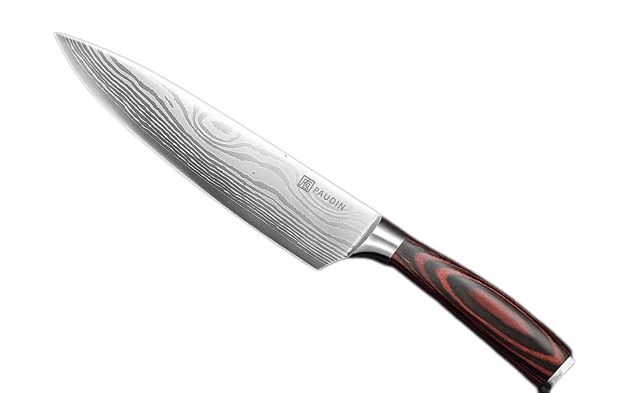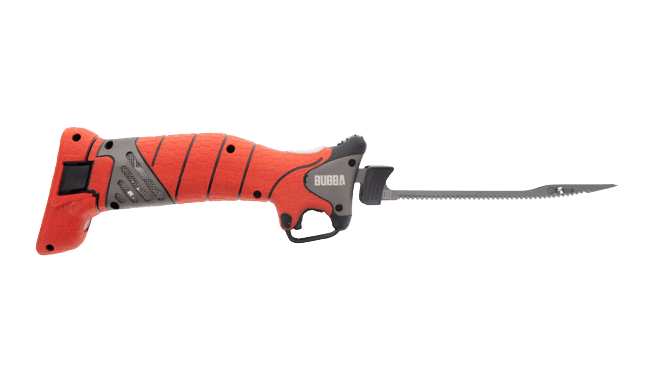An electric knife is a versatile kitchen tool that makes cutting through meat, bread, and other food items a breeze. Whether a professional chef or a home cook, an electric knife can save you time and effort when preparing meals. In this article, we’ll explore the key features to consider when choosing an electric knife and some of the best models available on the market. Here is a list of things you need to take into consideration when selecting an electric knife
Looking for the best electric knife on the market? Our Ultimate Guide has all the information you need to make an informed purchase.
NOTE: Electric knives are convenient and efficient kitchen tools. Still, it’s essential to consider the safety features of these knives before making a purchase. From blade safety features to electrical safety and ergonomic design, there are many factors to consider when selecting an electric knife that is safe and effective. By taking the time to understand the safety features of electric knives, you can ensure that you are using your knife safely and effectively in your kitchen.
1. what type of electric knife do you want
When it comes to choocing an electric knife, you got to decide what you’re going to use the knife for. Are you’r going to be using the knife for carving meats and veggies or fillet fish? An important question u should be asking seeing that there are two types of electric knives Carving and fillet electric knives.
Serrated blades are specially designed to cut through tough, crusty, and dense materials. These blades have teeth-like ridges that grip the surface of the material being cut and allow for a smooth, clean cut. Serrated blades are especially suitable for slicing bread, bagels, and other baked goods. They are also great for cutting tough meats like roast, ham, and turkey.
The two photos above show both carving and fillet electric knives. You can see from the pair of electric knife they look pretty similar, with a few slit differences.
Electric fillet knives are designed to make filleting fish easier and faster. They feature a motor and one or more blades that can be adjusted to various angles, making cutting through bones and flesh easier. While on the other hand, an Electric Carving knife is a simple kitchen appliance that allows you to easily cut through meats, bread, and vegetables. Both electric carving and electric fillet knives operate the same. Learn more about these electric knives here.
Now that you have decided between carving and fillet electric knives, there is another aspect you need to consider whether you want your electric knife corded or cordless. Let’s look at some examples :
Corded electric knives have a constant power supply and are ideal for heavy-duty cutting tasks. Cordless electric knives, on the other hand, offer more flexibility and mobility. Still, their battery life may limit the amount of cutting you can do. So consider your cutting needs and preferred mobility when choosing between corded and cordless electric knives.
2. power and motor of electric knife
Electric knives are an excellent addition to any kitchen, offering a variety of benefits that make them ideal for slicing a wide range of foods. Whether you need a powerful knife for use in the kitchen or a more portable option for outdoor use, there is an electric knife to suit your needs. When choosing an electric knife, it is crucial to consider your specific needs, such as the type of motor used, the power source, and the blade used.
Electrical Safety Features
Essential to consider electrical safety when using an electric knife. One of the most common electrical safety features is the safety switch. This switch is designed to prevent the blade from turning on, which can be a hazard if the knife is left unattended or someone accidentally touches the button while handling the knife. Some electric knives also come with automatic shut-off features, which will turn off the knife after a particular time, reducing the risk of electrical hazards.
Another electrical safety feature to consider is the insulation of the handle and cord. This insulation helps to prevent electrical shock and protects the user from electrical hazards. Additionally, many electric knives come with cord storage options, which allow you to neatly and safely store the cord when not in use, reducing the risk of tripping or damaging the cable.
Power Sources for Electric Knives
Electric knives can be powered by either AC or DC power. AC-powered electric knives require a power outlet, while DC-powered electric knives use batteries.
AC-powered electric knives are more powerful and offer a constant source of power. This makes them ideal for use in the kitchen where a power outlet is available. They are also less expensive than DC-powered electric knives.
On the other hand, DC-powered electric knives offer the convenience of being able to use them anywhere without needing a power outlet. They are also more portable and ideal for outdoor use or use in situations where a power outlet is unavailable.
Types of Motors Used in Electric Knives
Two main types of motors are used in electric knives – brushed and brushless. Brushed motors are the older technology and have been around for many years. They use a set of brushes that make contact with the spinning armature. This type of motor is less efficient and produces more noise and heat than brushless motors.
Brushless motors, on the other hand, are a more recent development and use an electronic control system to regulate the movement of the armature. This makes them much more efficient and produces less noise and heat. They are also more durable and require less maintenance.
When choosing an electric knife, it is important to consider your specific needs. For example, do you need a powerful knife for use in the kitchen or a more portable option for outdoor use? Do you prefer a brushed or brushless motor? Do you need an AC or DC-powered knife?
Once you have determined your specific needs, you can look at the various available models. Consider the size and weight of the knife, the type of motor used, and the power source.
3. the blades of the electric knife
The blade material of an electric knife can impact its durability and cutting ability. High-quality stainless steel blades are durable and provide clean, precise cuts. Consider the type of food you will be cutting and the frequency of use when choosing the blade material for your electric knife.
Choosing the right blade for your electric knife can be challenging, especially with the variety of available options. This article aims to help you understand the different types of electric knife blades, their benefits, and their suitability for various tasks.
Here I will list the different blades available for electric knives
Serrated Blades


Most, if not all, electric knives come with Serrated blades. They are specially designed to cut through tough, crusty, and dense materials. These blades have teeth-like ridges that grip the surface of the material being cut and allow for a smooth, clean cut.
Serrated blades are especially suitable for slicing bread, bagels, and other baked goods. They are also great for cutting tough meats like roast, ham, and turkey.
Stainless steel is the most commonly used material for electric knife blades, with outstanding durability, resistance to corrosion, and ease of maintenance. With high-quality stainless steel, the blade is forged, which lasts a long time.
Stainless Steel Blades

The advantage of stainless steel blades is that they retain their sharpness even after repeated use and are easy to sharpen when required.
Carbon Steel Blades

Carbon steel blades are considered the sharpest, and it’s durable. Carbon steel is a complex, durable material that is resistant to wear and tear, making it ideal for heavy-duty slicing tasks.
However, carbon steel blades require more maintenance and are prone to rusting if not correctly cared for.
Tungsten carbide blades are the most durable type of blade available. Tungsten carbide is a super-hard material that is highly resistant to wear and tear.
Tungsten Carbide Blades

These blades are ideal for heavy-duty slicing tasks, such as cutting through bones and are often used by commercial kitchens. However, they are more expensive than other blades and are not as readily available.
Ceramic Blades

Ceramic blades are the newest type of knife blades available in the market. Ceramic blades are made from a hard material that is resistant to corrosion, wear and tear, and bacteria. As a result, these blades are incredibly sharp and retain their sharpness for a long time.
They are also lightweight and do not rust or stain. However, the main disadvantage of ceramic blades is that they are brittle and can break if subjected to excessive force.
Blade Safety Features
The blade of an electric knife is one of the most critical parts, as it is responsible for cutting the food. As such, it is crucial to consider the safety features of the blade when purchasing an electric knife. One of electric knife blades’ most common safety features is the locking mechanism. This mechanism ensures that the blade stays securely in place when in use, reducing the risk of accidental cuts or injury.
Another vital safety feature to consider is the serrated edge. A serrated edge makes it easier to cut through tough or fibrous foods, such as bread or roasts, without putting too much pressure on the blade. This reduces the risk of the blade breaking or bending, which can be dangerous.
Blade Length
The length of the blade is also an essential factor to consider. A longer blade will allow you to cut larger pieces of food, while a shorter blade may be easier to maneuver and control. Consider the types of food you will be cutting and choose a blade length that will work best for your needs.
Choosing the right blade for your electric knife depends on your specific needs and preferences. If you are looking for a durable, easy-to-maintain, and suitable for a wide range of tasks, a stainless steel blade may be the right choice for you. A tungsten carbide or carbon steel blade may be better if you are looking for a durable, sharp, and suitable blade for heavy-duty slicing tasks.
Choosing the right blade for your electric knife is a crucial decision that can impact the effectiveness and longevity of your kitchen appliance.
4. Comfort and Ergonomics of the electric knife
Comfort and ergonomics are two essential factors to consider when choosing an electric knife. A comfortable electric knife will allow you to prepare food easily without straining your hand, wrist, or arm. An ergonomic electric knife will provide a comfortable grip and reduce the stress on your hand and wrist, allowing you to work for extended periods.
A comfortable electric knife should be lightweight, with a balanced weight distribution. The handle design should fit comfortably in your hand and provide a secure grip, even when your hands are wet or greasy. An ergonomic electric knife should also have a rubberized or textured handle to prevent slipping and ensure a comfortable grip.
Ergonomics also plays a vital role in the design of the blade. For example, a well-designed blade should have a curved or contoured shape that follows the natural curves of the food you are cutting, making it easier to cut through tough meats and vegetables with minimal effort. The blade should also be serrated or scalloped to prevent food from slipping, ensuring that you get precise, clean cuts every time.
Benefits of an Electric Knife with Comfort and Ergonomics
An electric knife that offers comfort and ergonomics will make your kitchen experience more enjoyable and efficient. Here are some of the benefits of choosing an electric knife that has these key features:
Easy to Use: A comfortable electric knife will make preparing your food easier without causing strain or discomfort in your hand or wrist. The lightweight design and balanced weight distribution make it easy to control and maneuver, even for long periods.
Precise Cuts: The ergonomic design of the blade and handle will make it easier for you to make precise cuts, ensuring that your food looks and tastes great. The curved or contoured shape of the blade will allow you to follow the natural curves of the food you are cutting, making it easier to create clean, precise cuts.
Durable: Electric knives with comfort and ergonomics in mind are made with high-quality materials built to last. As a result, you can enjoy the benefits of a comfortable electric knife for many years.
Safe: An electric knife with a comfortable, ergonomic design will be safer than a poorly designed knife. The rubberized or textured handle will provide a secure grip, even when your hands are wet or greasy, reducing the risk of accidents in the kitchen.
5. pricing of Electric knife
In this article, we will explore the pricing for electric knives, and what factors you should consider when purchasing one.
Factors that Affect Electric Knife Pricing
The price of an electric knife can vary greatly, depending on several factors, such as:
Blade Quality: The quality of the blade is one of the most critical factors that affect electric knife pricing. Higher quality blades are made from premium materials and are designed to last longer and cut more efficiently.
Brand: The brand of the electric knife is also a factor that affects pricing. Some of the most well-known brands in the electric knife market are Cuisinart, Black+Decker, and Hamilton Beach. They typically offer higher quality products at a premium price.
Size and Style: The size and style of the electric knife can also affect the price. For example, electric carving knives designed for larger cuts of meat are typically more expensive than electric bread knives.
Features: The number and type of features offered on an electric knife can also affect the price. For example, electric knives with a built-in carving fork or rechargeable batteries are typically more expensive than those without these features.
When purchasing an electric knife, many options are available to fit different budgets and needs. So whether you’re looking for a budget-friendly option for basic slicing tasks or a high-end knife for heavy-duty slicing, there is an electric knife for you. Consider the factors that affect electric knife pricing, such as blade quality, brand, size and style, and features, when making your decision.
FAQs
Here are some question and answers to some of the most commonly asked question on Electric knives
What can I cut with electric knife?
An electric knife can be used to cut a variety of foods, including meats, poultry, bread, fruits, and vegetables. Some common items that people use electric knives for include roasts, ham, turkey, bread loaves, and even foam for crafting projects.
The electric knife makes cutting easier and more efficient, especially for thicker cuts of meat or dense bread loaves. However, it’s important to use caution when using an electric knife, as the blade is sharp and can cause injury if not handled properly.
Are electric knives worth it?
yes, electric knives can be worth it if you frequently need to slice large cuts of meat, bread, or other foods, or if you have difficulty using a traditional knife. However, they may not be the best option for everyone, as some people may prefer the versatility and control offered by a traditional knife.
Do electric knives need sharpening?
Yes, electric knives do not typically need to be sharpened like traditional, manual knives because the blade is made of serrated stainless steel designed to last a long time without dulling.
However, the serrated edges can become worn over time, and the knife may not perform as well as it did when it was new. If this happens, you can consider having the blades professionally resharpened or replaced.
Final Thoughts
Choosing an electric knife can seem overwhelming, but with this comprehensive guide, you should now understand better what to look for. When selecting an electric knife, consider the blade material, length, shape, comfort, safety features, and brand. With so many options available, you’re sure to find the perfect electric knife to suit your needs.







